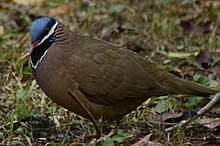Cuban pigeon
| Cuban pigeon | ||||||||||
|---|---|---|---|---|---|---|---|---|---|---|

Cuban pigeon ( Starnoenas cyanocephala ) |
||||||||||
| Systematics | ||||||||||
|
||||||||||
| Scientific name of the genus | ||||||||||
| Starnoenas | ||||||||||
| Bonaparte , 1838 | ||||||||||
| Scientific name of the species | ||||||||||
| Starnoenas cyanocephala | ||||||||||
| ( Linnaeus , 1758) |
The Cuban Pigeon ( Starnoenas cyanocephala ), also known as the Cuban earth pigeon , the blue -headed quail , the Cuban blue-headed pigeon or the partridge pigeon , is a species of pigeon birds. It occurs only on some islands in the Caribbean . It is the only representative of its genus and is considered endangered. The American earth pigeons are closely related to the cube pigeon .
Appearance
The cuboid pigeon reaches a body length of 31 centimeters. The weight averages 225 grams. There is no gender dimorphism .
Cuban pigeons have a dove-gray to light blue front and top of the head. A dark gray to black stripe runs over the eye from the base of the beak to the neck. It is bordered on the underside by a narrower white stripe that ends on the sides of the neck. The throat and upper chest are black. This black feather section is bordered by a narrow, partly interrupted white border. The top of the body is olive brown. The wings of the hand are a little darker and the individual feathers have a narrow rust-colored hem. The beak is red at the base and dark blue to black towards the tip. The iris is dark brown. The legs and feet are red.
It flies up with a whirring noise. The instrumental sound is reminiscent of that of the partridges . What is unusual about it is that it can fly straight up, similar to chickens.
Distribution, habitat and population development
The Cuban pigeon occurs in Cuba and the Isla de Pinos , occasionally also in Jamaica and on the south coast of Florida . It is a ground-dwelling forest pigeon that colonizes primeval forests. Their population has fallen sharply due to clearing and hunting, and it has become very rare in individual regions of its range. The population in Cuba is estimated at only 1,000 to 2,400 birds. The IUCN classifies the species as " endangered " (= highly endangered).
behavior
The Cuban pigeon eats seeds, berries and small snails. It can be found on the low branches of trees and twigs to rest and sleep. It builds its nest either directly on the ground or at a low height in the bushes. The nest is made up of dry twigs only very loosely. The clutch consists of two pure white eggs.
Keeping in human care
The cube pigeon was imported to England as early as 1794. The first owner in Germany was the Berlin Zoo from 1845 onwards. The London Zoo succeeded in breeding the first offspring in 1864. It is an extremely warmth-loving species that depends on a heated shelter.
supporting documents
Individual evidence
- ↑ Rösler, p. 225
- ^ Burnie, p. 249
- ↑ Rösler, p. 225 and p. 226
- ↑ Starnoenas cyanocephala in the endangered Red List species the IUCN 2008. Retrieved on 19 May, 2009.
- ↑ Münst, p. 167
- ↑ Rösler, p. 226
literature
- David Burnie (Ed.): Vögel , Munich 2008, Dorling Kindersley, ISBN 978-3-8310-1272-5 .
- David Gibbs, Eustace Barnes and John Cox: Pigeons and Doves - A Guide to the Pigeons and Doves of the World . Pica Press, Sussex 2001, ISBN 90-74345-26-3 .
- Alois Münst and Josef Wolters: Tauben - The species of wild pigeons , 2nd expanded and revised edition, Verlag Karin Wolters, Bottrop 1999, ISBN 3-9801504-9-6 .
- Gerhard Rösler: The wild pigeons of the earth - free living, keeping and breeding . M. & H. Schaper Verlag, Alfeld-Hannover 1996, ISBN 3-7944-0184-0 .
